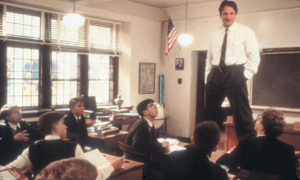 Learning is state dependent. This means that learning is most determined by the emotional state of the learner. I most recently heard this while watching a promotional video by Jim Kwik, the speed-reading and memory guru and head of Kwik Learning. But many before him have also said it: Learning is state dependent.
Learning is state dependent. This means that learning is most determined by the emotional state of the learner. I most recently heard this while watching a promotional video by Jim Kwik, the speed-reading and memory guru and head of Kwik Learning. But many before him have also said it: Learning is state dependent.
Think about it—rarely can we meaningfully absorb new or much information when we are fearful, angry, or bored. Instead, we learn when we are joyful, open, excited, and engaged. Try to remember a trip to a place you were intensely interested in—a certain museum, natural wonder, or sporting event. Taking in information was easy and exciting.
Now, think about your students. What state are they in when they sit in your class? Some students have the ability to put themselves in a motivated state because they want good grades. Many, however, go through the entire day in a neutral or even negative state.
The good news is: States can change instantly. One joke, one encounter with a friend, one surprise text or call can put us in a good mood. As Robert Frost put it in “Dust of Snow”:
The way a crow
Shook down on me
The dust of snow
From a hemlock tree
Has given my heart
A change of mood
And saved some part
Of a day I had rued.
Just because students may come into our class in negative states doesn’t mean they have to stay that way.
Every human being has the power to control his or her state, but that’s a tall order for children and adolescents. We can help them. Here are some ideas:
- Unabashedly show your love for the content. Passion for content makes us look vulnerable and dorky, but who cares? That vulnerability taps into something deeply human in all who see it. You’re showing the students your genuine self, not the polished, perfect, “so-much-older-and-smarter” you. And when you’re so enthusiastically engaged, students will become engaged. Get dorky.
- Be funny, but not sarcastic. I am not a naturally funny person—my three younger brothers will attest to that! Some teachers are, and students love being around them, because their states are lifted. However, I find that jokes come easily when I’m being genuinely passionate about the subject and I don’t care if I look dumb. But never toward the students—nothing tanks a classroom state more than an attempted “bust” on a student gone sour.
- Think of fun and collaborative activities. Let the students be funny on their own. This is even better than being a teacher who is funny, since the students generate their own states. I am never disappointed when I give students an activity that has leeway for humor. Students want to laugh and be funny in front of each other. Why not harness that impulse and tie it to your content? Parodies, Twitter conversations between characters, and acting out scenes are just three of the easiest ways to set up some fun in class.
- Have students move around. Moving around feels good. The students might not know it, but their bodies know it. Our bodies and brains can induce emotional states that we don’t necessarily intend. For example, when we slump for a period of time, we will begin to feel tired and bored, even if we weren’t before. When we smile, stand tall, or do some kind of “power stance,” our states will change for the better, even if we weren’t originally feeling better. It’s the “Fake it till you make it” philosophy (for more on this, see Amy Cuddy’s Presence or watch her TED talk here). If students are slumped in their seats, get them up with group work, acting, a march around the room to an iambic beat as you read Shakespeare, a yoga pose, a ball toss, anything. The energy in the room will change.
 Incorporate art and music. Creating art and music is an innate human drive. (For my extended thoughts about music in the classroom, click here.) For many students, even older ones, drawing, coloring, cutting paper, folding, and gluing really engages them. As teachers, we often dismiss this as fluff and not content, but artistically processing content reflects a deep level of learning. Creating videos and animation also immediately engages students. And a box of cheap, dollar-store instruments can go a long way.
Incorporate art and music. Creating art and music is an innate human drive. (For my extended thoughts about music in the classroom, click here.) For many students, even older ones, drawing, coloring, cutting paper, folding, and gluing really engages them. As teachers, we often dismiss this as fluff and not content, but artistically processing content reflects a deep level of learning. Creating videos and animation also immediately engages students. And a box of cheap, dollar-store instruments can go a long way.- Tie your content to something in their worlds. Learning about Confucius is somewhat interesting, but imagining what Confucius would say to Kanye West or Bella Swan is much more interesting, and funny (see #3). Think of ways to apply content to their real lives. I’ve had students write essays comparing the love triangle in King Arthur to the love triangle in The Living Dead, or the character of Gilgamesh to Spongebob Squarepants. See what they can come up with.

- Use games. Games are great for review, and most teachers have their favorite ones. This year, I discovered “Kahoot” and it was insanely fun as a midterm review. (To sign up as a teacher on Kahoot, click here). The students wanted to play it again and again, even though they quickly learned all the answers. I’ve never seen anything like it. Like art, games engage another human drive: a little friendly competition within oneself and with each other.
As a teacher, you have the power to change the states of the students in your classroom. Never doubt that. There’s a reason why the world’s top speakers blast inspirational music as participants enter the auditorium, and why comedians and musicians have warm-up acts. They want people in a positive, receptive state when they begin. We can achieve some form of that in our classrooms, and solidify learning even more deeply in our students.

Great post, thank you! Learning is even more state dependent than teaching 😉
I agree!! Putting oneself in an open, receptive state conducive to learning is more important for the learning process. Teaching usually puts me in a great state…but my state doesn’t help students learn if they aren’t open to learning.